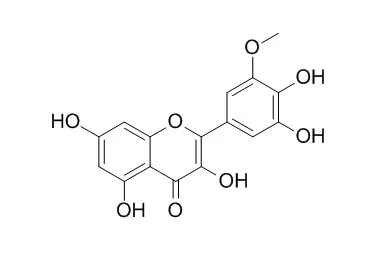| Kinase Assay: |
| Food Chemistry, 2013, 138(4):2267-2274. | | Identification of novel dietary phytochemicals inhibiting the efflux transporter breast cancer resistance protein (BCRP/ABCG2).[Reference: WebLink] | Breast cancer resistance protein (BCRP/ABCG2) plays an important role in determining the absorption and disposition of consumed xenobiotics including various drugs and dietary phytochemicals and is also one of the prominent efflux transporters involved in multidrug resistance (MDR).
METHODS AND RESULTS:
In this study, we have investigated the interactions between ABCG2 and 56 naturally-occurring phytochemicals including phenolic acids, flavonoids, triterpenes and other common dietary phytochemicals, as well as two non plant-based compounds (hippuric acid and propyl gallate) using cell- and membrane-based transport inhibition assays. Of the non-flavonoid phytochemicals tested, berberine, celastrol, ellagic acid, limonin, oleanolic acid, propyl gallate, sinapic acid and ursolic acid demonstrated significant inhibition of ABCG2-mediated transport. Chrysoeriol, Laricitrin, myricetin 3′,4′,5′-trimethylether, pinocembrin, quercitrin, tamarixetin, tricetin and tricetin 3′,4′,5′-trimethylether were also identified as novel flavonoid ABCG2 inhibitors.
CONCLUSIONS:
The identified inhibitory activity of dietary phytochemicals on ABCG2 provides a framework for further investigation of ABCG2-modulated phytochemical bioavailability, MDR, and possible food–drug interactions. |
|
| Structure Identification: |
| Food Chemistry, 2013, 139(1-4):289-299. | | Antioxidant capacity, polyphenolic content and tandem HPLC–DAD–ESI/MS profiling of phenolic compounds from the South American berries Luma apiculata and L. chequén.[Reference: WebLink] | Native Myrtaceae fruits were gathered by South American Amerindians as a food source. At present, there is still some regional consume of the small berries from trees belonging to genus Luma that occurs in southern Chile and Argentina. The aerial parts and berries from Luma apiculata and Luma chequen were investigated for phenolic constituents and antioxidant capacity.
METHODS AND RESULTS:
A high performance electrospray ionisation mass spectrometry method was developed for the rapid identification of phenolics in polar extracts from both species. Thirty-one phenolic compounds were detected and 27 were identified or tentatively characterised based on photodiode array UV–vis spectra (DAD), ESI–MS–MS spectrometric data and spiking experiments with authentic standards. Twelve phenolic compounds were detected in L. apiculata fruits and 12 in the aerial parts while L. chequen yielded 10 compounds in fruits and 16 in aerial parts, respectively. From the compounds occurring in both Luma species, seven were identified as tannins or their monomers, 15 were flavonol derivatives and five were anthocyanins. The whole berry and aerial parts extracts presented high antioxidant capacity in the DPPH assay (IC50 of 10.41 ± 0.02 and 2.44 ± 0.03 μg/mL for L. apiculata, 12.89 ± 0.05 and 3.22 ± 0.05 for L. chequen, respectively), which can be related to the diverse range of phenolics detected. The antioxidant capacity together with the high polyphenolic contents and compounds identified can support at least in part, their use as botanical drugs.
CONCLUSIONS:
From the compounds identified in both species, 3-O-(6″-O-galloyl)-hexose derivatives of myricetin, quercetin, Laricitrin and isorhamnetin are reported for the first time for the genus Luma. |
|






 Cell. 2018 Jan 11;172(1-2):249-261.e12. doi: 10.1016/j.cell.2017.12.019.IF=36.216(2019)
Cell. 2018 Jan 11;172(1-2):249-261.e12. doi: 10.1016/j.cell.2017.12.019.IF=36.216(2019) Cell Metab. 2020 Mar 3;31(3):534-548.e5. doi: 10.1016/j.cmet.2020.01.002.IF=22.415(2019)
Cell Metab. 2020 Mar 3;31(3):534-548.e5. doi: 10.1016/j.cmet.2020.01.002.IF=22.415(2019) Mol Cell. 2017 Nov 16;68(4):673-685.e6. doi: 10.1016/j.molcel.2017.10.022.IF=14.548(2019)
Mol Cell. 2017 Nov 16;68(4):673-685.e6. doi: 10.1016/j.molcel.2017.10.022.IF=14.548(2019)